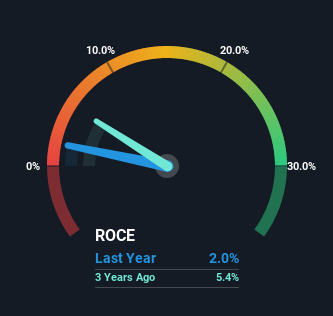- New Zealand
- /
- Electric Utilities
- /
- NZSE:CEN
Some Investors May Be Worried About Contact Energy's (NZSE:CEN) Returns On Capital

When we're researching a company, it's sometimes hard to find the warning signs, but there are some financial metrics that can help spot trouble early. Typically, we'll see the trend of both return on capital employed (ROCE) declining and this usually coincides with a decreasing amount of capital employed. Basically the company is earning less on its investments and it is also reducing its total assets. So after glancing at the trends within Contact Energy (NZSE:CEN), we weren't too hopeful.
Return On Capital Employed (ROCE): What Is It?
Just to clarify if you're unsure, ROCE is a metric for evaluating how much pre-tax income (in percentage terms) a company earns on the capital invested in its business. The formula for this calculation on Contact Energy is:
Return on Capital Employed = Earnings Before Interest and Tax (EBIT) ÷ (Total Assets - Current Liabilities)
0.02 = NZ$90m ÷ (NZ$5.4b - NZ$795m) (Based on the trailing twelve months to December 2022).
Thus, Contact Energy has an ROCE of 2.0%. Ultimately, that's a low return and it under-performs the Electric Utilities industry average of 5.4%.
See our latest analysis for Contact Energy

Above you can see how the current ROCE for Contact Energy compares to its prior returns on capital, but there's only so much you can tell from the past. If you'd like, you can check out the forecasts from the analysts covering Contact Energy here for free.
So How Is Contact Energy's ROCE Trending?
We are a bit worried about the trend of returns on capital at Contact Energy. Unfortunately the returns on capital have diminished from the 4.5% that they were earning five years ago. And on the capital employed front, the business is utilizing roughly the same amount of capital as it was back then. Since returns are falling and the business has the same amount of assets employed, this can suggest it's a mature business that hasn't had much growth in the last five years. If these trends continue, we wouldn't expect Contact Energy to turn into a multi-bagger.
What We Can Learn From Contact Energy's ROCE
In summary, it's unfortunate that Contact Energy is generating lower returns from the same amount of capital. But investors must be expecting an improvement of sorts because over the last five yearsthe stock has delivered a respectable 98% return. Regardless, we don't feel too comfortable with the fundamentals so we'd be steering clear of this stock for now.
Contact Energy does have some risks, we noticed 3 warning signs (and 2 which shouldn't be ignored) we think you should know about.
While Contact Energy may not currently earn the highest returns, we've compiled a list of companies that currently earn more than 25% return on equity. Check out this free list here.
New: AI Stock Screener & Alerts
Our new AI Stock Screener scans the market every day to uncover opportunities.
• Dividend Powerhouses (3%+ Yield)
• Undervalued Small Caps with Insider Buying
• High growth Tech and AI Companies
Or build your own from over 50 metrics.
Have feedback on this article? Concerned about the content? Get in touch with us directly. Alternatively, email editorial-team (at) simplywallst.com.
This article by Simply Wall St is general in nature. We provide commentary based on historical data and analyst forecasts only using an unbiased methodology and our articles are not intended to be financial advice. It does not constitute a recommendation to buy or sell any stock, and does not take account of your objectives, or your financial situation. We aim to bring you long-term focused analysis driven by fundamental data. Note that our analysis may not factor in the latest price-sensitive company announcements or qualitative material. Simply Wall St has no position in any stocks mentioned.
About NZSE:CEN
Contact Energy
Generates and sells electricity and natural gas in New Zealand.
Fair value second-rate dividend payer.
Similar Companies
Market Insights
Community Narratives



